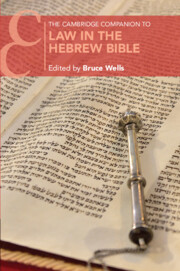Book contents
- The Cambridge Companion to Law in the Hebrew Bible
- Cambridge Companions to Religion
- The Cambridge Companion to Law in the Hebrew Bible
- Copyright page
- Contents
- Contributors
- Abbreviations
- Introduction
- Part I The Historical Context of Biblical Law
- Part II The Biblical Legal Collections
- Part III The Biblical Laws
- Part IV Biblical Law and Other Scriptural Discourses
- Part V The Legacy of Biblical Law
- Bibliography
- Subject Index
- Text Index
- Cambridge Companions To Religion (continued from page iii)
- References
Part IV - Biblical Law and Other Scriptural Discourses
Published online by Cambridge University Press: 11 April 2024
- The Cambridge Companion to Law in the Hebrew Bible
- Cambridge Companions to Religion
- The Cambridge Companion to Law in the Hebrew Bible
- Copyright page
- Contents
- Contributors
- Abbreviations
- Introduction
- Part I The Historical Context of Biblical Law
- Part II The Biblical Legal Collections
- Part III The Biblical Laws
- Part IV Biblical Law and Other Scriptural Discourses
- Part V The Legacy of Biblical Law
- Bibliography
- Subject Index
- Text Index
- Cambridge Companions To Religion (continued from page iii)
- References
Summary

- Type
- Chapter
- Information
- The Cambridge Companion to Law in the Hebrew Bible , pp. 179 - 238Publisher: Cambridge University PressPrint publication year: 2024
References
Select Bibliography
All sources for the references in this chapter are in the volume’s main bibliography.
Select Bibliography
All sources for the references in this chapter are in the volume’s main bibliography.
Select Bibliography
All sources for the references in this chapter are in the volume’s main bibliography.

